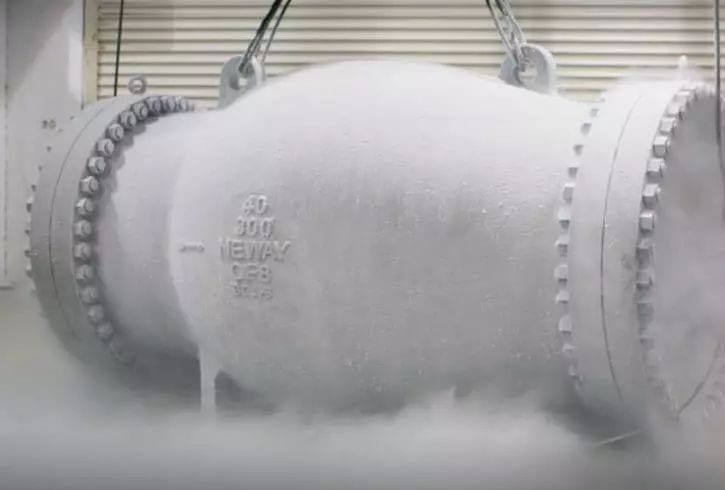Plumbing Valve Website
Features of the shipping industry
The shipyard is very minimalist. As a result, there is very little space on board. Operators must reduce the size to make the gas tank as small as possible. They do this by liquefying the natural gas (LNG, Liquefied Natural Gas). By cooling it to approximately the point where the natural gas becomes liquid. At temperatures of -165°C, the main isolation valve must still work.
What affects the valve design?
The temperature has an important impact on the design of the valve. For example, users may need it for hot environments like the Middle East. Or, it may be suitable for cold environments like the polar seas. Both of these environments can affect the sealing and durability of the valve. The components of these valves include the valve body, bonnet, stem, stem seal, ball valve and seat. Due to their material composition, these components expand and contract at different temperatures.
Low-Temperature Application Options
Option 1.
Operators use the valves in cold environments, such as oil rigs in polar waters.
Option 2.
Operators use valves to manage fluids at temperatures well below freezing.
In the case of highly flammable gases, such as natural gas or oxygen, the valve must also be operated correctly in the event of a fire.
Pressure problems
There is an accumulation of pressure during the normal handling of the refrigerant. This is due to the increase in ambient heat and subsequent vapor formation. Special care needs to be taken in the design of the valve/piping system. This allows pressure build-up.
Temperature problems
Dramatic temperature changes can affect worker and plant safety. Each component of a cryogenic valve expands and contracts at different rates due to different material compositions and the length of time they are subjected to the refrigerant.
Another major problem when handling refrigerant is the increase in heat from the surrounding environment. These heat increases are the reason manufacturers isolate valves and piping.
In addition to the high-temperature range, the valves must also deal with considerable challenges. For liquefied helium, the temperature of the liquefied gas drops to -270°C.
Function Problem
Conversely, if the temperature drops to absolute zero, valve function becomes very challenging. A cryogenic valve connects a pipe to a liquid gas in the environment. It does so at ambient temperature. The result can be a temperature difference of up to 300°C between the pipeline and the environment.
Efficiency Issues
The temperature difference creates a flow of heat from the warm zone to the cold zone. It can impair the proper function of valves. It can also reduce the efficiency of the system in extreme cases. This is of particular concern if ice forms at the warm end.
However, this passive heating process is also used intentionally in low-temperature applications. This process is used to seal the valve stem. Typically, valve stems are sealed with plastic. These materials cannot withstand low temperatures, but a high-performance metal seal of two components that move a lot in opposite directions is just very expensive and almost impossible.
Sealing problems
There is a very simple solution to this problem. You bring the plastic used to seal the valve stem to an area where the temperature is relatively normal. This means that the sealant for the valve stem must be kept at a distance from the fluid.
The hood of the engine is like a pipe. If fluid rises through this pipe, it will warm from the outside. When the fluid reaches the stem sealant, it is mainly at ambient temperature and is gaseous. The engine hood also prevents the handle from freezing and not starting.
A challenge for the seal! There is a very simple solution to this problem! You bring the plastic used to seal the valve stem to an area where the temperature is relatively normal. This means that the sealant for the valve stem must be kept at a distance from the fluid.
Selecting a valve for low temperature service
Selecting valves for cryogenic applications can be complex. Buyers must consider both shipboard and plant conditions. Also, the specific properties of cryogenic fluids require specific valve performance. Proper selection ensures plant reliability, equipment protection and operational safety. There are two main valve designs used in the global LNG market.
Valve design for the global LNG market
Three-bias rotary tight isolation valve
These deflections allow the valve to open and close. They operate with very little friction and rubbing. One of the challenges of LNG storage is trapped cavities. In these cavities, the liquid can expand explosively more than 600 times. The three-rotation tight isolation valve eliminates this challenge.
Single and Double Baffle Check Valves
These valves are critical components in liquefaction equipment because they prevent damage caused by flow reversal. Material and size are important considerations, as cryogenic valves are expensive. The results of an incorrectly sized valve can be detrimental.
How can an engineer ensure that a cryogenic valve is sealed?
Leaks are very expensive when one considers the cost of making the gas into a refrigerant in the first place. It’s also dangerous.
A big problem with cryogenic technology is the potential for valve seat leaks. Buyers often underestimate the radial and linear growth of the stem in relation to the body. If the buyer chooses the right valve, they can avoid these problems.
I recommend using a cryogenic valve made of stainless steel. This material responds well to temperature gradients during operations with liquefied gases. The cryogenic valve should be made of a suitable sealing material with a seal up to 100 bar.
In addition, the extension of the bonnet is a very important feature as it determines the sealability of the valve stem sealant.
 VIGA Faucet Manufacturer
VIGA Faucet Manufacturer 


